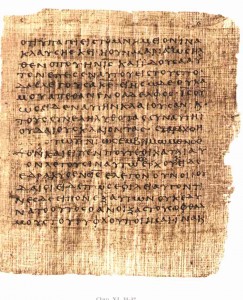Take a close look at the two Greek manuscripts in this post. What I want you to concentrate on is the lower right hand corner of each of these pieces of papyri. What you should notice is the fraying, deterioration, and disappearance of this part of the manuscript. Contrast this with the left hand margin of these two papyri which are in tact. This pattern is regularly apparent to the observant student of Greek papyri. Why? Because in antiquity as in the 20th century with VHS tapes, people didn’t not always heed the advice— ‘please be kind and rewind’. Greek is a language read left to right, and so the extreme right of a document would often be left exposed to the elements. The results are readily apparent. One loses the end of the document.
Papyri, as we have said earlier in our ‘Memory’ posts last Fall, deteriorated quite readily in moist climates. They were made up of Nile reeds, vegetable matter, after all. It is then no surprise that we find so few papyri in Galilee and so many in the arid conditions at Qumran or in the deserts of Egypt. You can’t judge literacy very well on the basis of where you find manuscripts since ‘absence of evidence does not indicate evidence of absence’ in a moist climate when it comes to papyri and literacy, and this brings us to Mark’s Gospel and its ending.
I remain utterly unconvinced by the arguments that Mark 16.8 is the original ending of that Gospel, an ending that involves all sorts of problems including the fact that it is unprecedented for a document to end with ‘ephobounto gar…’ (See Clayton Croy on ‘The Mutilation of Mark’). No, it seems quite likely the ending of Mark was lost due to deterioration as with the papyri shown above. If for example p46 is a guide, we can well account for the loss of say 10 lines or so of script in the final column of the Gospel, just enough for a version of Mt. 28.9-10 and an edited form of the appearance to men and women in Galilee later in Mt. 28. In other words, I don’t really think the ending of Mark is totally lost. I think the First Evangelist used Mark in Mt. 28 as elsewhere he has used 95% of Mark’s Gospel. What should be added is that the second and later century additions such as the Freer logion, or the long ending (16.9ff.) were attempts in the early church to supply an ending because the church recognized Mark 16.8 couldn’t have been the ending.
Of course this is bad news for the KJV only/Majority Texters, but good news for Protestants in snake handling Kentucky, as it means that those verses about snake handling and drinking poison are not an original part of the inspired text of Mark’s Gospel. In short, ‘text should determine canon’ not the other way around, and this being so, if Mk. 16.9ff. is not an original part of Mark’s Gospel, which it surely is not, then it shouldn’t be in our English translations. Final note— Mk. 16.9-20 is probably too long anyway, to have fit at the end and bottom of the final column of Mark’s Gospel if it was written in a fair hand in majuscule, or even if it was written in minuscule Greek script.














